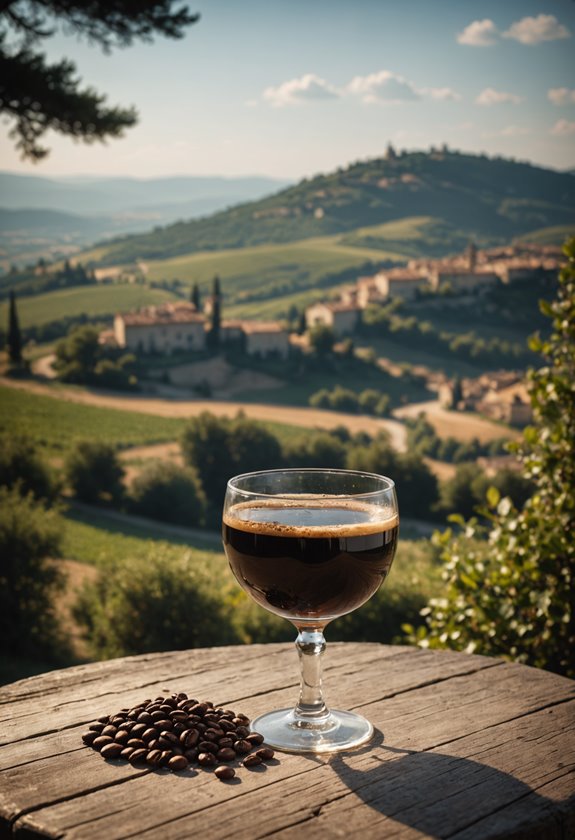Why Do You Put Coffee Beans in Sambuca?
Let's investigate why coffee beans are paired with sambuca in the Italian tradition "Sambuca con la mosca." You place three coffee beans in sambuca to represent well-wishes: health, happiness, and prosperity. This custom ties back to Italian cultural values, where they believe the odd number of beans brings luck, aligning with the Christian symbolism of the Holy Trinity. The roasted aroma of coffee beans complements sambuca's sweet anise flavor, enhancing the drinking experience. Additionally, when you chew these soaked beans, they intensify the anise's notes, adding a sensory layer to this ritual. Continue to learn more about this fascinating practice.
Key Takeaways
- Coffee beans enhance sambuca's flavor with a roasted aroma that complements its anise notes.
- Three beans symbolize health, happiness, and prosperity, aligning with Italian cultural values.
- Odd numbers of beans are believed to bring extra luck and blessings.
- Chewing the soaked beans intensifies the sambuca's anise flavors and adds to the sensory experience.
- The beans' presentation reflects a respect for Italian tradition and enhances the aesthetic appeal.
Origin and Tradition

When you enjoy sambuca with three coffee beans, you're taking part in a tradition that embodies Italian cultural values. This practice, known as "Sambuca con la mosca," is more than just a serving method—it's a tribute to health, happiness, and prosperity. These three coffee beans aren't merely for decoration; they enhance the sambuca experience with deep-rooted significance.
The Tradition of Sambuca and Coffee Beans
In Italian customs, sambuca is cherished as a digestif, often served after meals to aid digestion. The addition of coffee beans not only improves the drink's flavor but also aligns with religious traditions.
The number three holds a special place in Christianity, symbolizing the Holy Trinity: Father, Son, and Holy Spirit. This adds a layer of spiritual depth to the ritual.
Enhancing Flavor and Experience
Each coffee bean is carefully roasted to bring out its aroma, creating a perfect harmony with sambuca's anise notes.
After sipping, you're encouraged to chew the beans, which intensifies the liqueur's flavor, making it a memorable tasting experience.
This isn't just about taste; it's about participating in a cultural ritual that celebrates life's joys and communal gatherings.
Let's investigate how this tradition reflects Italian values, improving your understanding of this charming custom.
Symbolism and Meaning
The symbolism behind sambuca with coffee beans runs deep, offering more than just a pleasing aesthetic. In Italian tradition, these three coffee beans are more than mere garnish—they carry a powerful message of well-wishes for the drinker. Representing health, happiness, and prosperity, these beans are part of a practice known as "Sambuca con la mosca," which means "sambuca with the fly." This practice is steeped in symbolism, reflecting the significance of the number three in Christianity. The three beans are a nod to the Holy Trinity, adding layers of meaning to this traditional Italian ritual.
Let's examine the cultural beliefs tied to this tradition. The odd number of beans is thought to bring extra luck, aligning with superstitions surrounding fortune and blessings. Each bean contributes to a unique sensory experience, complementing the sambuca's distinct anise flavor.
Flavor and Experience

While the symbolism of sambuca with coffee beans brings a deeper meaning to the drink, it's the flavor and experience that truly captivate the senses. When you add coffee beans to sambuca, the rich, roasted aroma blends beautifully with the anise notes. This combination creates a charming flavor profile that highlights both elements.
Let's examine how this traditional Italian ritual enhances your drinking experience.
As you sip sambuca, savor the roasted coffee beans floating in the glass. Their aroma amplifies the sweetness of the sambuca's anise, providing a full-bodied experience. Once you've enjoyed the drink, don't forget to chew the soaked beans. This action intensifies the anise flavors, offering a unique sensory experience that's both aromatic and flavorful.
The coffee beans contain beneficial antioxidants that add nutritional value to this traditional drink. Toasting the coffee beans by lighting the sambuca on fire adds drama to the ritual. This technique not only intensifies the crispy texture of the beans but also enriches the overall experience, making it unforgettable.
This practice connects you to Italian customs, deepening your appreciation of this classic beverage. With every sip and chew, you're participating in a time-honored tradition that celebrates the harmonious marriage of coffee and sambuca.







